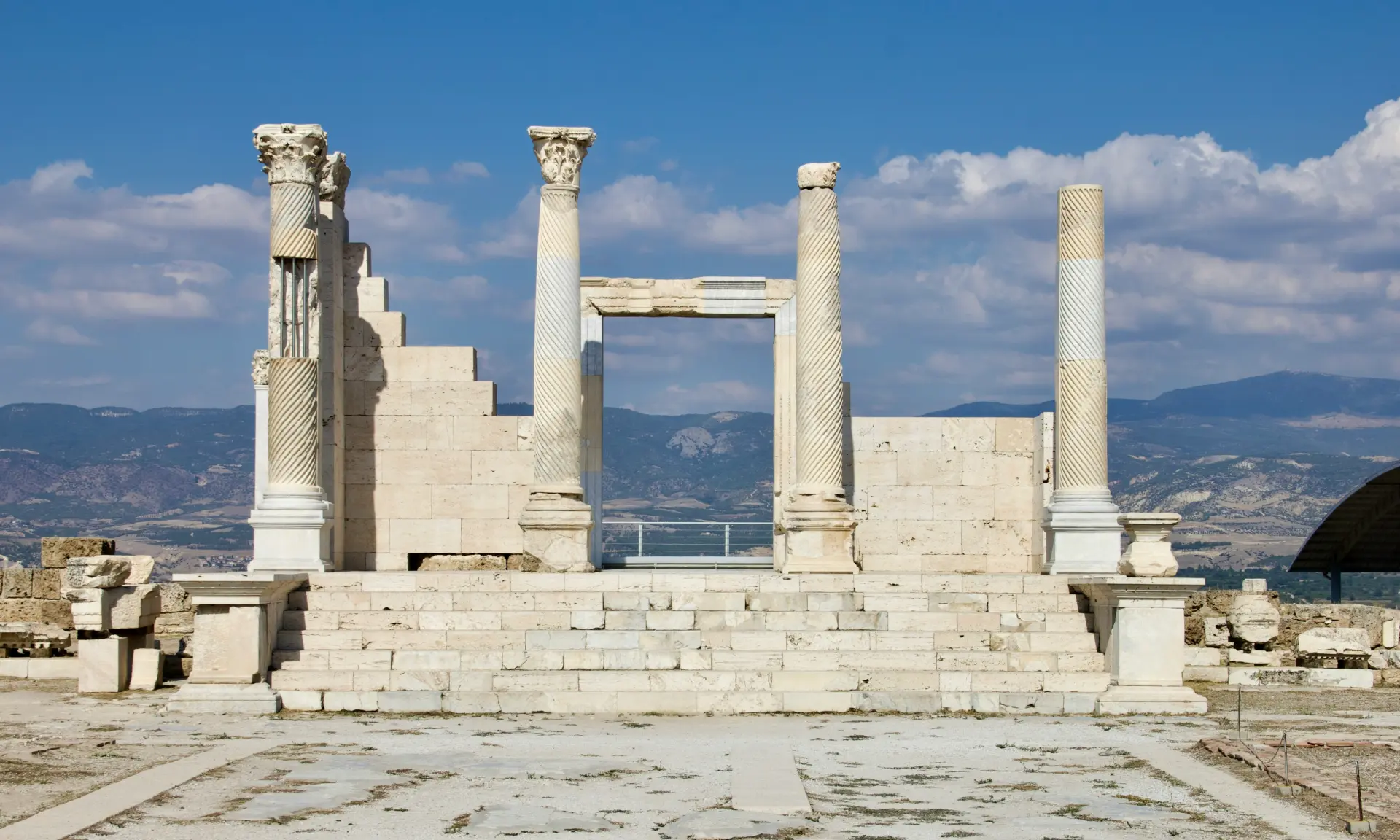Is the Western Church the Church of Laodicea Spoken of in Revelations?
The book of Revelation is often viewed as a mysterious and challenging book – one that many people avoid reading. In it God reveals what His wrath against the unbelieving world will look like at the end of the age. Fortunately, it is not written to scare or worry those who believe in Christ as their Lord and Savior, rather it was written as a reassurance of God’s control of events worldwide and across time and His plan to rescue His people Israel and to protect His saints. I am often asked whether believers today will be required to endure the wrath of God during the Tribulation spoken of in Revelation and Daniel. It is abundantly clear that we will not be here but rather will be raptured.
Today we are turning our attention to Revelation 2 and 3 where Jesus is addressing the seven churches. These are critical passages for many reasons. First, they indicate that the judgement has not yet begun during the church time. Second, they give us a prophetic look into the history and future of the church across the church age. Finally, they indicate that the church will not be part of the final judgement of earth as the churches are not mentioned again in Revelation after chapter 3.
Jesus addresses three real, existing churches in these two chapters, and He has both good and bad news for most of them. The pattern of each letter is roughly the same while Jesus commends the various churches for what they have done right and then condemns them for their failings. He concludes each letter with the words:
All the letters are interesting and should be studied in depth but in this article, we will be focusing on the church of Laodicea.
General Threefold Interpretation of The Letters to The Churches
There is wide agreement as to the interpretation of the seven churches in Revelation chapters 2 and 3 as representing more than just literal churches of the time. This view is held by many biblical scholars who take a high view of scripture. This interpretation generally encompasses three main applications:
Historical Application: The letters were addressed to actual churches in Asia Minor (modern-day Turkey) during the time of John’s writing, around the end of the first century AD. These churches were Ephesus, Smyrna, Pergamum, Thyatira, Sardis, Philadelphia, and Laodicea. This is the most straightforward and widely accepted interpretation, focusing on the literal and historical context of the churches. In Rev 1:11 John is told to
As a result we know that all of these letters (as well as the entire book of Revelation) was shared between these seven churches and many others of that time.
Prophetic Application (Church Ages): This interpretation says that the seven churches symbolically represent different periods in the history of the Christian Church from the apostolic age to the end times. It typically follows a pattern where each church represents an age starting from the apostolic age (Ephesus) and ending with an age of apostasy or lukewarm Christianity (Laodicea). There is some disagreement on the exact delineation of these ages or when they began and ended. The prophetic interpretation of the church ages can be traced back to various theologians and scholars over the centuries, with its popularization in modern times often linked to figures in the dispensationalist movement like John Nelson Darby in the 19th century. This view is not held by all evangelical scholars or leaders but is finding greater acceptance recently. Of those who hold this view of prophetic interpretation most believe that we are in the “Laodicean” age, characterized by a lukewarm, complacent, or apostate church.
Universal Application: This view holds that the messages to the seven churches are timeless and can apply to any church at any point in history. It suggests that the spiritual conditions described in the letters can be found in churches throughout the ages, making the messages perpetually relevant.

Examining The Church Age
The Prophetic Application of the seven churches in Revelation, often referred to as the “Church Ages” view, interprets each of the seven churches as representing a distinct period in the history of the Christian Church. This interpretation is particularly popular among Christians, teachers and theologians who hold a high view of scripture. Here’s a general outline of how these church ages are typically mapped to historical periods, along with their scriptural basis:
Ephesus (Revelation 2:1-7) – Apostolic Church Age (circa 30-100 AD):
- Scriptural Characteristics: Losing first love, hard work, and perseverance.
- Historical Period: This age corresponds to the early church era, beginning with the ministry of the Apostles and characterized by initial fervor and doctrinal purity but eventually leading to a decline in zeal and love.
Smyrna (Revelation 2:8-11) – Age of Persecution (circa 100-313 AD):
- Scriptural Characteristics: Suffering, poverty, and persecution but remaining faithful.
- Historical Period: This period covers the intense persecutions faced by Christians, particularly under Roman emperors like Nero, Domitian, and Diocletian.
Pergamum (Revelation 2:12-17) – Compromised Church Age (circa 313-600 AD):
- Scriptural Characteristics: Living where Satan has his throne, yet holding fast to Jesus’ name, with some doctrinal compromise.
- Historical Period: Marked by the church’s establishment as a state religion under Constantine and subsequent doctrinal compromises and entanglement with secular power.
Thyatira (Revelation 2:18-29) – Age of the Papacy (circa 600-1517 AD):
- Scriptural Characteristics: Tolerating false prophets, idolatry, and sexual immorality as they tolerate (or even embrace) Jezebel. Those who are untainted Jesus calls on them to hold fast.
- Historical Period: Representing the medieval church dominated by the Papacy, characterized by corruption, the sale of indulgences, and the Inquisition.
Sardis (Revelation 3:1-6) – Reformation Church Age (circa 1517-1750 AD):
- Scriptural Characteristics: Having a reputation of being alive, but being dead; call to wake up and strengthen what remains.
- Historical Period: Corresponds to the Protestant Reformation, which sought to address the corruptions of the Catholic Church but, according to this view, retained some doctrinal errors.
Philadelphia (Revelation 3:7-13) – Missionary Church Age (circa 1750-1900 AD):
- Scriptural Characteristics: Little strength, kept Jesus’ word, and not denied His name.
- Historical Period: This era is marked by great missionary movements, evangelical revivals, and a focus on adherence to the word of God, despite external weaknesses.
Laodicea (Revelation 3:14-22) – Apostate Church Age (circa 1900-present):
- Scriptural Characteristics: Lukewarm, neither hot nor cold, materially rich but spiritually poor.
- Historical Period: Viewed as the current age, characterized by a church that is complacent, self-sufficient, and lacking in true spiritual zeal or depth.
Living in The Last Days
Many events are unfolding in our world that led us to consider that we are living in the last days and the return of Christ is near. Of course, other generations have thought that too. Significant is the gathering of Israel back to its own land. An event that was unimaginable 100 years ago. Today, as you scan the newspaper or watch TV news you feel like you are reading Matthew 24:9-12:
And Revelation 3:15-17:
So, the question is – are we living during the time of the church of Laodicea? Many Bible teachers have espoused this view including John MacArthur, Charles Stanley, and Tim LaHaye. David Jeremiah, the senior pastor at Shadow Mountain agrees with the view that the Laodicean church is reflective of today’s Church. He cites John Stott, noting that the Laodicean church’s characteristics—respectable, sentimental, nominal, skin-deep religiosity—are widespread in modern Christianity, which he describes as “flabby and anemic.” 1

Before we go on let’s understand just who the Laodiceans were and learn a little more about their city, as we continue to paint this portrait of a Christian body that is lukewarm.
The ancient city of Laodicea, mentioned in the Book of Revelation as one of the seven churches, was a significant and wealthy city in the Roman province of Asia, located in what is now modern-day Turkey. Here are some key historical aspects of Laodicea:
Location and Importance: Laodicea was strategically located at the crossroads of major trade routes, near the Lycus River valley. It was part of a tri-city area, which included Colossae and Hierapolis. Its location contributed to its economic prosperity and cultural significance.
Wealth and Commerce: Laodicea was known for its wealth, derived from its banking industry, textile production, and a medical school. The city was particularly famous for its production of black wool and a popular eye salve.
Earthquake and Self-Sufficiency: The city was damaged by an earthquake around AD 60, but it was rebuilt without the financial aid of Rome. This self-sufficiency might be reflected in the words of Revelation 3:17, where the church in Laodicea is described as saying,
The Christian Community: Christianity reached Laodicea not long after the death of Christ, possibly brought by Paul’s companions. The Apostle Paul mentions Laodicea in his letter to the Colossians (Colossians 2:1; 4:13-16), urging the Colossians to share his letter with the church in Laodicea.
Archaeological Remains: Modern archaeological excavations have uncovered many ruins in Laodicea, including a large stadium, theatres, a council house (bouleuterion), and remnants of an aqueduct system. These findings have given insights into the city’s grandeur and prosperity.
The Church Without a Good Report
The letter to the Laodicean church in Revelation is notable for its rebuke of the church’s lukewarm faith. It is the only letter among the seven in which the recipient church is offered no praise, no good report. The letter criticizes the church for its complacency, spiritual indifference, and reliance on material wealth. This is a church that has lost its way.
Looking closer at the text we can see how it aligns with this idea that we are living in the time of the church of Laodicea. Revelation 3:15-22 is the letter to Laodicea that Jesus gave to John. It reads:
Lukewarmness (Rev. 3:15-16): There is no doubt that today we see a general complacency and lack of zeal in contemporary Christianity. Since COVID-19 church attendance has generally been down 10 to 30 across most churches. Today people do not seek out the church for answers to life’s challenges and few if any non-saved enter a church regularly. Those that attend are spiritually indifferent, lacking in passion for Christ, and content with a mediocre commitment to faith. No wonder Jesus admonitions these Christians against being “neither cold nor hot”.
Self-Deception and Materialism (Rev. 3:17): The Laodicean church’s claim of being “rich” and in “need of nothing” is seen as paralleling the modern church’s focus on material wealth and success, at the expense of spiritual depth and dependence on God. I have observed that today we have become too busy to do the work of Christ. Many contemporary churches have become self-satisfied and blind to their own spiritual poverty.

Call to Repentance and Spiritual Renewal (Rev. 3:18-19): The counsel to “buy from me gold refined in the fire” and to put on “white clothes” is often interpreted as a call to genuine faith and purity, emphasizing the need for a return to authentic Christian doctrine and lifestyle. The call for repentance and the promise of discipline for those God loves is seen as a direct message to today’s churches to rekindle their commitment to biblical truth and holiness.
Divine Invitation (Rev. 3:20): The image of Christ standing at the door and knocking is an ongoing invitation for individual believers and churches to re-establish a close relationship with Him. It is important to realize He will not knock forever. Head Jesus warning in Matthew 25:1-13. There will come a time when the door will be closed and locked tight. Those coming to the door will be told ‘Truly, I say to you, I do not know you.’
Promise to Overcomers (Rev. 3:21): The promise to those who overcome to sit with Christ on His throne is seen as an encouragement to remain faithful amidst spiritual lukewarmness and decline. This is interpreted as a call for perseverance and faithfulness in a time perceived as spiritually challenging perhaps even a time of persecution which could exist before Christ comes for His church.
As we consider this church at the end of the age, and we consider the state of the current Western Church we are left with a clear understanding of the moral and spiritual decline that Jesus was addressing to the church of Laodicea and how it aligns with what we see today. Consider what is happening in and outside of the church that leads us to this conclusion:
Cultural Assimilation: Churches that closely align with the surrounding culture, often adopting its values and attitudes, sometimes at the expense of biblical teachings, can be seen as losing their distinctiveness and fervor for the Gospel.
Material Prosperity and Self-Sufficiency: Wealth and comfort can lead to a sense of self-sufficiency that diminishes a perceived need for God or a reliance on faith, mirroring the Laodicean church’s claim of being “rich” and “in need of nothing.”
Moral and Doctrinal Compromise: When churches or believers compromise on key biblical teachings or moral standards to accommodate societal changes or avoid controversy, it can be seen as a sign of lukewarmness.
Lack of Evangelistic Zeal: A decline in evangelism or a lack of concern for sharing the faith with others can be interpreted as a symptom of lukewarmness, indicating a loss of passion for the core mission of the church.
Spiritual Apathy: A general lack of enthusiasm for spiritual disciplines like prayer, Bible study, and worship, or a declining participation in church life, are often cited as indicators of a lukewarm faith at best.
Prosperity Gospel: The prevalence of the “prosperity gospel” in some Christian circles, which often equates material wealth and success with God’s favor, is seen as a modern manifestation of the love of wealth. This theology will lead to a misplaced emphasis on material gain and a neglect of spiritual truths.
Consumerism in the Church: The influence of consumerism within the church, where success is measured by numbers, budgets, and facilities, can be perceived as a form of materialism. This perspective suggests that such an emphasis detracts from the church’s spiritual mission and depth.
Spiritual Complacency in Wealthy Societies: In affluent societies, there can be a tendency for comfort and wealth to lead to spiritual complacency or a sense of self-sufficiency that diminishes perceived dependence on God. Wealth often makes one a slave to belongings and ties the faithful down preventing them from carrying out the work of God.
Application
What are we to do then if we are authentic saints, called by Christ and living in accordance with the convictions of the Holy Spirit? If we are living in the age of the Laodicean church—the last of the church ages as described in the Book of Revelation—there are several implications and calls to action to remain pure during this time, to persevere until Christ calls us home.
Awareness of Spiritual State: The first step is to recognize and acknowledge the spiritual lukewarmness, complacency, or self-deception that may be present in our individual lives and in the church collectively. This involves a sincere self-assessment and a willingness to confront uncomfortable truths about one’s faith and practice.
Call to Repentance: Revelation 3:19 emphasizes,
This call to repentance is central. It involves turning away from spiritual indifference, materialism, and other forms of sin, and turning back to God with sincerity and commitment. We need to seek to live a sanctified life that emulates Christ.
Deepening Relationship with Christ: The image of Jesus standing at the door and knocking (Rev. 3:20) is seen as an invitation to deepen one’s personal relationship with Christ. This means prioritizing time for prayer, scripture reading, and other spiritual disciplines that foster a closer walk with God.
Renewed Focus on Biblical Teaching: There is a call to return to sound biblical teaching and to uphold the authority of Scripture. This includes both personal study of the Bible and seeking out churches and communities where the Bible is faithfully taught and lived out.
Commitment to Authentic Faith: Moving beyond a superficial or nominal Christianity to an authentic faith that impacts every area of life. This means living out Christian values and principles in personal, family, and community life as we endeavor to be more Christlike.
Engagement in Evangelism and Service: A renewed emphasis on evangelism and serving others, reflecting the Great Commission (Matthew 28:19-20) and the call to be salt and light in the world (Matthew 5:13-16). This involves sharing the gospel and engaging in acts of service and kindness. We have to realize that the only Jesus the world might see if us – we need to reflect him and be ready with in and out of season to explain the hope that we have in Christ.
Preparation for Christ’s Return: There is little doubt that the end times are near. I can tell you with authority they are one day closer than yesterday! We need to emphasize the importance of being spiritually awake and prepared for Christ’s return. This includes both personal spiritual readiness and encouraging others to come to faith in Christ.
Fostering Christian Community and Fellowship: Strengthening bonds within the Christian community, encouraging and supporting one another in faith, and building up the body of Christ.
Resisting Cultural Conformity: Actively resisting the pressure to conform to secular culture in ways that compromise Christian values and beliefs, and instead, seeking to transform culture through the influence of the gospel.
Conclusion
Let us be the light of the world in these troubled days, whether they are the last or not. Let us live unto the Lord worthy of the great salvation we have in Christ Jesus. Let us choose to not be part of the church of the last age languishing in apathy unaware that we are lukewarm. Rather let us do as Rev 3: 18 tells us:
References
David Jeremiah (2022) – https://davidjeremiah.blog/christs-message-for-the-seven-churches-of-revelation-and-today/




